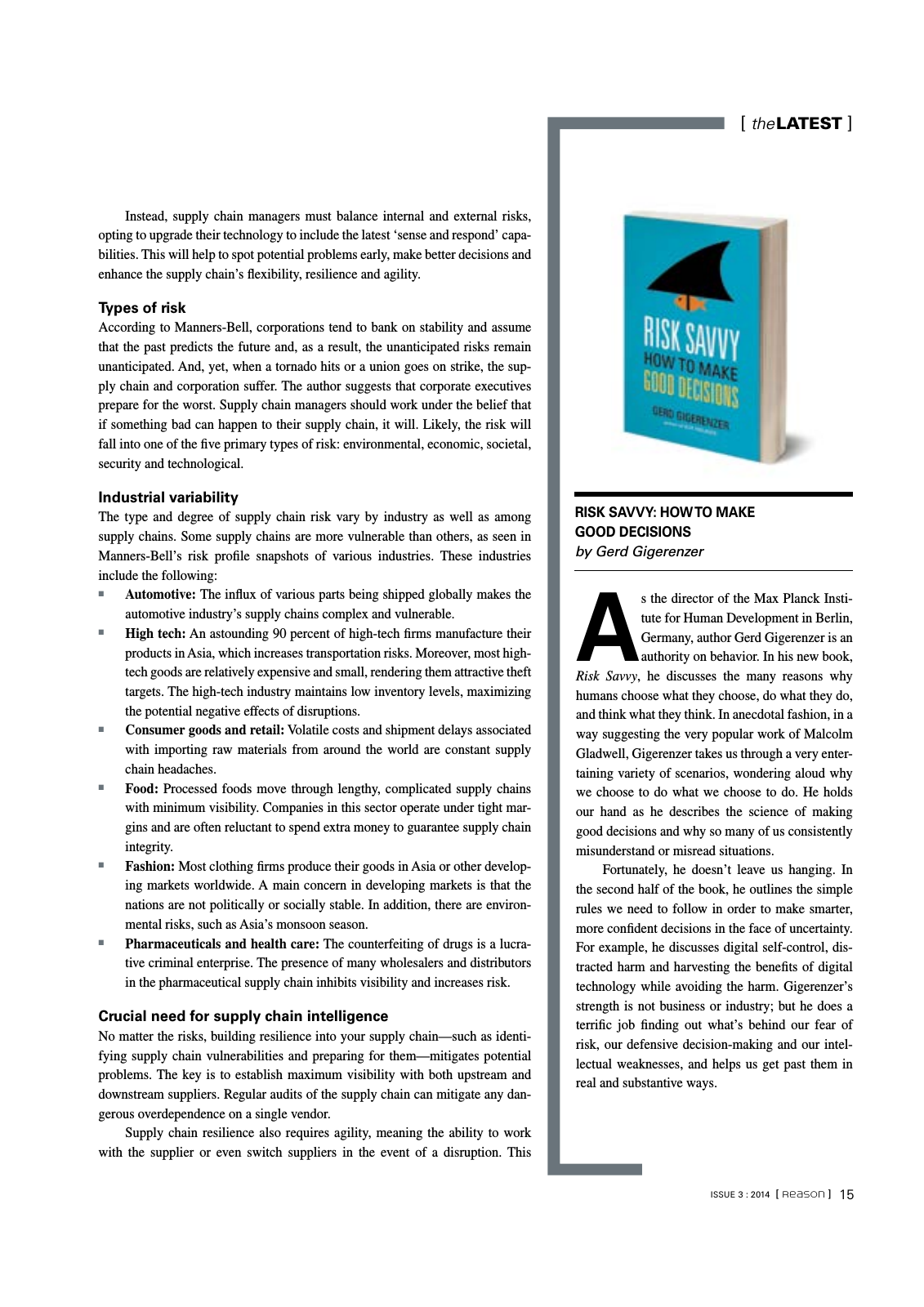Reason Magazin 2014Q3 Seite 15
Hinweis: Dies ist eine maschinenlesbare No-Flash Ansicht.Klicken Sie hier um zur Online-Version zu gelangen.
Inhalt
ISSUE 3 2014 Reason 15 theLATEST Instead supply chain managers must balance internal and external risks opting to upgrade their technology to include the latest sense and respond capa bilities This will help to spot potential problems early make better decisions and enhance the supply chain s flexibility resilience and agility Types of risk According to Manners Bell corporations tend to bank on stability and assume that the past predicts the future and as a result the unanticipated risks remain unanticipated And yet when a tornado hits or a union goes on strike the sup ply chain and corporation suffer The author suggests that corporate executives prepare for the worst Supply chain managers should work under the belief that if something bad can happen to their supply chain it will Likely the risk will fall into one of the five primary types of risk environmental economic societal security and technological Industrial variability The type and degree of supply chain risk vary by industry as well as among supply chains Some supply chains are more vulnerable than others as seen in Manners Bell s risk profile snapshots of various industries These industries include the following Q Automotive The influx of various parts being shipped globally makes the automotive industry s supply chains complex and vulnerable Q High tech An astounding 90 percent of high tech firms manufacture their products in Asia which increases transportation risks Moreover most high tech goods are relatively expensive and small rendering them attractive theft targets The high tech industry maintains low inventory levels maximizing the potential negative effects of disruptions Q Consumer goods and retail Volatile costs and shipment delays associated with importing raw materials from around the world are constant supply chain headaches Q Food Processed foods move through lengthy complicated supply chains with minimum visibility Companies in this sector operate under tight mar gins and are often reluctant to spend extra money to guarantee supply chain integrity Q Fashion Most clothing firms produce their goods in Asia or other develop ing markets worldwide A main concern in developing markets is that the nations are not politically or socially stable In addition there are environ mental risks such as Asia s monsoon season Q Pharmaceuticals and health care The counterfeiting of drugs is a lucra tive criminal enterprise The presence of many wholesalers and distributors in the pharmaceutical supply chain inhibits visibility and increases risk Crucial need for supply chain intelligence No matter the risks building resilience into your supply chain such as identi fying supply chain vulnerabilities and preparing for them mitigates potential problems The key is to establish maximum visibility with both upstream and downstream suppliers Regular audits of the supply chain can mitigate any dan gerous overdependence on a single vendor Supply chain resilience also requires agility meaning the ability to work with the supplier or even switch suppliers in the event of a disruption This A s the director of the Max Planck Insti tute for Human Development in Berlin Germany author Gerd Gigerenzer is an authority on behavior In his new book Risk Savvy he discusses the many reasons why humans choose what they choose do what they do and think what they think In anecdotal fashion in a way suggesting the very popular work of Malcolm Gladwell Gigerenzer takes us through a very enter taining variety of scenarios wondering aloud why we choose to do what we choose to do He holds our hand as he describes the science of making good decisions and why so many of us consistently misunderstand or misread situations Fortunately he doesn t leave us hanging In the second half of the book he outlines the simple rules we need to follow in order to make smarter more confident decisions in the face of uncertainty For example he discusses digital self control dis tracted harm and harvesting the benefits of digital technology while avoiding the harm Gigerenzer s strength is not business or industry but he does a terrific job finding out what s behind our fear of risk our defensive decision making and our intel lectual weaknesses and helps us get past them in real and substantive ways RISK SAVVY HOW TO MAKE GOOD DECISIONS by Gerd Gigerenzer
